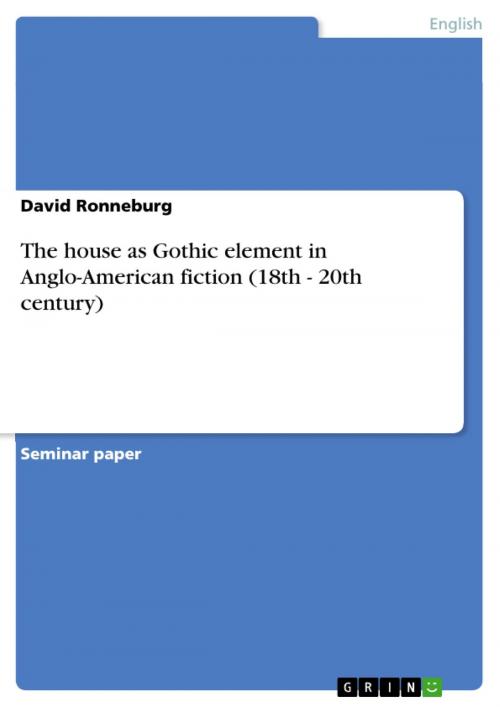The house as Gothic element in Anglo-American fiction (18th - 20th century)
20th century)
Fiction & Literature, Literary Theory & Criticism, British| Author: | David Ronneburg | ISBN: | 9783638429016 |
| Publisher: | GRIN Publishing | Publication: | October 17, 2005 |
| Imprint: | GRIN Publishing | Language: | English |
| Author: | David Ronneburg |
| ISBN: | 9783638429016 |
| Publisher: | GRIN Publishing |
| Publication: | October 17, 2005 |
| Imprint: | GRIN Publishing |
| Language: | English |
Seminar paper from the year 2002 in the subject English Language and Literature Studies - Literature, grade: 1,0, University of Leipzig (Anglistik), course: The Gothic Inheritance, 48 entries in the bibliography, language: English, abstract: Diese in englischer Sprache verfasste Arbeit beschäftigt sich mit verschiedenen Erscheinungsformen und Funktionen, in denen das 'Haus-Motiv' als 'gothic element' in der Angloamerikanischen Literatur auftritt. Zu diesem Zweck werden zahlreiche Prosatexte von Autoren wie F.H. Burnett, A.C. Doyle, B. Stoker, C. Brontë, C. Dickens, D. du Maurier, O. Wilde, J.K. Rowling, N. Hawthorne, M. Twain, W. Faulkner und C.P. Gilman auf das Haus-Motiv hin untersucht, analysiert und im Gothic-Kontext interpretiert.
Seminar paper from the year 2002 in the subject English Language and Literature Studies - Literature, grade: 1,0, University of Leipzig (Anglistik), course: The Gothic Inheritance, 48 entries in the bibliography, language: English, abstract: Diese in englischer Sprache verfasste Arbeit beschäftigt sich mit verschiedenen Erscheinungsformen und Funktionen, in denen das 'Haus-Motiv' als 'gothic element' in der Angloamerikanischen Literatur auftritt. Zu diesem Zweck werden zahlreiche Prosatexte von Autoren wie F.H. Burnett, A.C. Doyle, B. Stoker, C. Brontë, C. Dickens, D. du Maurier, O. Wilde, J.K. Rowling, N. Hawthorne, M. Twain, W. Faulkner und C.P. Gilman auf das Haus-Motiv hin untersucht, analysiert und im Gothic-Kontext interpretiert.















